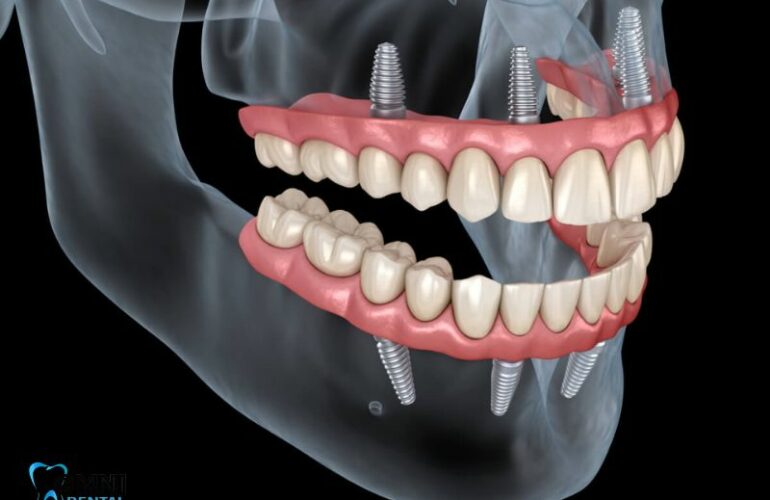When it comes to replacing your front teeth, one of the most popular options is dental veneers. Veneers are thin shells made from porcelain or composite resin bonded to the front surface of a tooth and can be used to improve the appearance of teeth damaged by decay, discoloration, chips, or cracks. But before deciding whether veneers are right for you, it’s essential to understand their pros and cons.
Veneers as a Front Tooth Replacement Option
Veneers are a popular cosmetic dentistry option for those looking to replace or improve the appearance of their front teeth. They are thin, custom-made shells placed over a tooth’s front surface to improve its shape, size, and color. Veneers are typically made of porcelain or composite resin, and they can be used to correct various cosmetic problems such as misshapen teeth, discoloration, and gaps between teeth.
What are Veneers, and How Do They Work?
Veneers are a type of dental restoration used to improve the appearance of the front teeth. They are made of either porcelain or composite resin and placed over a tooth’s front surface to improve its shape, size, and color. Getting veneers typically involves removing a small amount of tooth enamel, making an impression of the tooth, and then placing the veneer over the tooth. The veneer is then bonded to the tooth using special dental cement.
The Pros of Veneers as a Front Tooth Replacement
One of the main benefits of veneers is that they can provide instant results. They can improve the appearance of misshapen, discolored, or gapped teeth and give patients a more attractive and natural-looking smile. Veneers are also stain resistant and can be a good option for those who have trouble keeping their teeth white due to certain foods and beverages. Additionally, veneers can be a good option for those with sensitive teeth because they can help to protect the tooth’s surface.
The Cons of Veneers as a Front Tooth Replacement
One of the main drawbacks of veneers is that they can be relatively high cost. They are considered cosmetic procedures and may not be covered by dental insurance. Additionally, getting veneers requires removing tooth enamel, making the tooth more sensitive to hot and cold temperatures. Veneers also have a lifespan of around 10-15 years, after which they need to be replaced.
Comparing Veneers to Other Front Tooth Replacement Options
Veneers vs. Dental Crowns
Regarding front tooth replacement options, veneers and dental crowns are often compared. Both options can be used to improve the appearance of your front teeth, but they have some key differences. Dental crowns are typically recommended for teeth that have been heavily damaged or have had a root canal.
They are also used to hold a bridge in place. In contrast, veneers are typically recommended for minor cosmetic problems, such as misshapen or discolored teeth.
One of the main differences between veneers and crowns is that veneers only cover the tooth’s front surface, while crowns encase entirely the tooth. This means veneers are less invasive and do not require as much tooth reduction as crowns. However, this also means that veneers may not be suitable for teeth that have been heavily damaged or have had a root canal.
Another difference between veneers and crowns is that veneers are typically made of porcelain. In contrast, crowns can be made of various materials, such as porcelain-fused-to-metal, zirconia, or all-ceramic. Porcelain veneers are highly stain-resistant and can mimic the appearance of natural teeth very closely. However, they can be more fragile than other dental veneers, so you must be mindful of what you eat and drink to avoid chipping or cracking your veneers.
Veneers vs. Dental Implants
Dental implants are a more permanent solution for missing or damaged front teeth, while veneers are a more cosmetic option. Implants are anchored into the jawbone and function like natural teeth, while veneers are placed over existing teeth. Implants can also be more costly than veneers and require more extensive oral surgery.
Veneers vs. Traditional Dentures
Traditional dentures are an option for front tooth replacement, but they are not as secure or natural-looking as veneers. Dentures are removable and can slip or move in the mouth, while veneers are bonded to the tooth and do not move. Dentures also require regular adjustments and maintenance, while veneers typically only need to be replaced every 5-10 years.
However, dentures can be less stable and secure than veneers or dental implants. They can also make it difficult to eat certain foods and can cause discomfort or sore spots on the gums. Dentures also need to be removed for cleaning and can be bulky and inconvenient to carry around.
Dental Front Tooth Replacement Options in Arlington Heights
At Omni Dental in Arlington Heights, IL, we are committed to helping our patients find the right front tooth replacement option that fits their needs and budget. Whether you’re looking for veneers, dental crowns, implants, or dentures, our experienced professionals will help you through every step.
We understand how important it is for your smile to look its best and strive to ensure each patient leaves with a beautiful result they can be proud of. Contact us today to learn more about your options for front tooth replacement!







